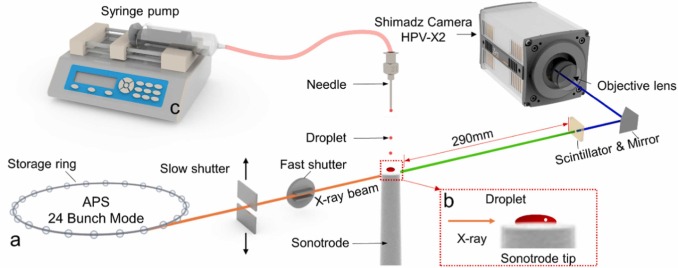Efficiency and sustainability are now among the most important priorities in modern metallurgical production. Companies are actively searching for solutions that can help reduce operating costs while also addressing the growing need to lower CO₂ emissions. In response, innovative metal processing methods are gaining rapid traction. Additive manufacturing is one of the driving forces behind this transformation, but to truly optimize the entire production chain, it is essential to focus not only on the manufacturing process itself, but also on the efficient preparation of high-quality metal powder feedstock.
Ultrasonic Metal Atomization technology
Ultrasonic metal atomization technology offers a modern, highly efficient alternative to conventional powder production methods. The process involves melting the metal and delivering it onto a vibrating ultrasonic sonotrode. High-frequency ultrasonic vibrations break the molten stream into fine, uniform droplets, which rapidly solidify into spherical powder particles. This method provides exceptional control over particle size distribution and morphology, surpassing the capabilities of gas, water, or centrifugal atomization.
Unlike traditional methods, ultrasonic atomization operates with lower energy input and can efficiently process various feedstocks, including reactive materials thank to melting in cold copper crucible. The resulting powders typically exhibit better flowability, and more consistent properties as ultrasonic treatment additionally influence the crystallization, making them ideal for demanding applications such as additive manufacturing, advanced coatings, and specialized sintering processes.
Enhancing production efficiency
One of the key advantages of ultrasonic metal atomization is its ability to significantly enhance production efficiency through precise control over particle size and morphology. The ultrasonic vibrations applied during the process create uniform capillary wave instabilities, resulting in highly consistent droplet sizes before solidification. This leads to powders with a narrow particle size distribution and an exceptionally spherical shape, characteristics that are critical for ensuring high packing density, optimal flowability, and uniform melting behavior. This precision directly impacts the quality of final metallurgical products, particularly in additive manufacturing applications such as Laser Powder Bed Fusion (LPBF), Direct Energy Deposition (DED), and Binder Jetting.
Powders with controlled morphology and size lead to improved layer deposition, reduced defects, higher part density, and enhanced mechanical properties in the manufactured components. Moreover, the ability to tailor powder characteristics enables better material performance, shorter process development times, and greater flexibility in designing alloys specifically optimized for advanced manufacturing techniques.
Reducing Waste in Production Processes
Ultrasonic metal atomization technology plays a crucial role in reducing waste across production processes by offering the flexibility to process a wide range of raw materials, including primary metals, production scrap, and previously used powders. This capability enables the direct recycling of waste streams that would otherwise be discarded or require extensive reprocessing, often including environmentally harmful chemicals. A prominent example of this application is the recycling of failed 3D printed parts.
Defective prints or support structures, which typically accumulate during additive manufacturing operations, can be remelted and reatomized to produce high-quality, reusable powders with controlled particle size and morphology. By turning waste into valuable feedstock, ultrasonic atomization supports both economic performance and the transition towards more circular industrial practices.
Ultrasonic Metal Atomizer in action: Transforming industrial applications
Ultrasonic metal atomizers are transforming industrial applications by enabling flexible, high-efficiency powder production from a wide variety of raw materials and alloys. Devices such as the ultrasonic metal atomizer developed by AMAZEMET demonstrate how compact, laboratory-scale systems can be used to produce high-quality powders from both conventional and advanced materials, including titanium, aluminum, refractory metals, and high-entropy alloys. The technology’s ability to handle different feedstock forms — from standard ingots to irregular scrap pieces — provides significant versatility for research institutions, specialized manufacturers, and recycling facilities. Moreover, ultrasonic atomization has proven particularly effective in the production of precious metal powders, such as gold, silver, and platinum group metals.
Thanks to the minimal material losses associated with the precise and localized melting process, users can maximize recovery rates of valuable metals, making the process both economically attractive and resource-efficient. This combination of adaptability, high yield, and material conservation makes ultrasonic atomizers a powerful tool in industries where material cost, quality, and sustainability are critical factors.
The future of Ultrasonic Atomization: What lies ahead?
The future of ultrasonic metal atomization is closely tied to technological advancements and material innovation, particularly in the development of sonotrodes. Current research focuses on creating more durable sonotrode materials, including ceramic matrix composites (CMC), capable of withstanding extreme thermal and mechanical stresses during long-term operation.
New designs incorporating optimized geometries and cooling strategies are being developed to further enhance atomization efficiency, and expand the range of processable alloys, including refractory and reactive metals. Opportunities for broader process optimization also include higher-frequency ultrasonic systems for finer droplet control and advanced real-time monitoring to ensure consistent powder quality.
Looking ahead, ultrasonic atomization is expected to find applications in emerging industries such as energy storage, where uniform powders are critical for battery electrodes, and hydrogen technologies, which rely on specialized metal hydrides. Furthermore, engineering sectors are increasingly demanding high-purity, tailor-made powders, making ultrasonic atomization a key enabler for future manufacturing. As industries seek greater sustainability and precision, the continuous evolution will ensure that ultrasonic atomization remains at the forefront of advanced metal powder production.



































